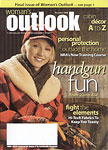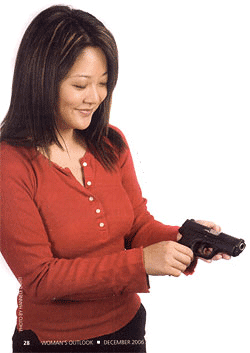
Kahr Arms P45
Woman's Outlook, Dec. 2006, p. 28 - 29, 63 By Gila Hayes
 The Kahr P45 delivers a big .45-caliber cartridge with surprisingly low recoil.
The Kahr P45 delivers a big .45-caliber cartridge with surprisingly low recoil.
In 11 short years, handgun manufacturer Kahr Arms has grown to a well-established firm listing 17 models of pistols on its website. Until recently, Kahr Arms handguns were chambered only in 9 mm and .40 S&W, but that has all changed with the latest addition, a long-awaited polymer-framed .45 pistol, dubbed the P45. Kahr pistols are compact and streamlined, a tradition that lives on in the new .45. Despite chambering for a major caliber, the P45 weighs just 18.5 ounces unloaded, and is only slightly larger then earlier micro-compacts from this manufacturer. Its overall dimensions are 6.3 inches long and 4.8 inches high. This slide is just an inch wide, and encloses a 3.54-inch barrel. The minimalist grip holds a magazine containing six rounds of ammunition.
Designed for personal protection, the slide of the P45 is nicely rounded, with a beveled muzzle to ease into a holster. Like other polymer-framed models from Kahr, the P45’s grip frame is molded with roughly pebbled side panels and deep checkering on both the front strap and the backstrap, securing the gun in the hand through the recoil of the .45 ACP cartridge.
Kahr’s striker-fired handguns operate in double action only (DAO), with no manual safety. The trigger’s long 5/8-inch pull required six pounds to discharge the sample P45 I tested.
Prime Polymer
In 1999 when Kahr Arms added a polymer-framed model to its heavy all-steel pistol product line, many were surprised how well the diminutive polymer frame withstood the battering of recoil. Not long thereafter, Kahr surprised us again with another polymer-framed micro-pistol firing the admittedly abrupt .40 S&W caliber. And Kahr is doing it again: A .45 ACP would seem to push the limits of the polymer frame, but Frank Harris of Kahr Arms told me that design upgrades addressed areas under particular stress. For example, the barrel lug is widened to better distribute contact between it and the slide stop pin. The polymer rails do not take the impact; rather, steel rails molded into the polymer frame both fore and aft take 90 to 95 percent of the impact. Also, a slight “U” shape machined into the polymer portions of the frame rail prevents cracks in that material.
Live-fire Experience
When I went to the range with the lightweight, I wondered how such a small, light gun would handle the recoil of the big .45 ACP cartridge. Curious, I gathered a variety of ammunition from CCI, Federal, Black Hills Ammunition and Winchester. One load from Black Hills Ammunition, a 230-grain jacketed hollow-point (JHP) +P cartridge had both the stiffest recoil and the best accuracy.
Still, I wouldn’t say the P45’s recoil strings any worse than a .45-caliber 1911-pattern alloy-framed super-compact pistol. The P45’s good fit and low bore axis do a good job distributing recoil. The molded polymer frame accommodates an extremely thin, little grip, offering small-handed shooters less twisting under recoil. While there is no way to completely mitigate the recoil, it’s easier to realign the sights when the grip remains seated firmly in the shooter’s hands! From the 25-yard line, I found the P45 good for 4-inch groups on average. A dozen rounds into initial testing, I had to tape my thumb and index finger. Were this my own handgun, I would find a gunsmith to round the lower corner of the slide stop and the bottom of the trigger.
Shooting Drills
 Top right: The P45’s magazine follower’s steel insert contacts the slide stop to lock the pistol open when the magazine is empty;
Bottom right: The externally designed wide, heavy-duty extractor is a hallmark of the P45.
Top right: The P45’s magazine follower’s steel insert contacts the slide stop to lock the pistol open when the magazine is empty;
Bottom right: The externally designed wide, heavy-duty extractor is a hallmark of the P45.
After the 25-years accuracy tests, I ran the small handgun through several reloading drills. Angled edges molded into the bottom of the magazine well partnered with the P45’s single-column magazines, making reloading fumble-free.
Next, I took the little .45 to the steel plate range, where the recoil of the big .45 cartridges in such a small-framed gun finally caught up with me. Shot-to-shot times are inevitably a bit longer than with a similar gun in 9mm or a full-size steel-framed .45. Because the gun didn’t batter my hand as badly as expected, I’d overlooked its muzzle rise until now.
Realistically, due to recoil, the P45 is not a beginner’s handgun. However, experienced shooters seeking a concealable .45 should be elated with this new Kahr. The sample I borrowed worked flawlessly, and proved reasonably accurate for a micro-compact semi-auto.
Coming Attractions
Kahr Arms plans an October 2006 release of a slightly larger model along the lines of its “Tactical” version. The TP45 will have a 4.04-inch barrel and seven-round magazines. If the P45 is a DAO equivalent of the old 1911 Officer’s Model, the next, slightly larger version should resemble the Commander variant of the 1911. Both Kahrs, however, are slimmer and considerably lighter than even alloy 1911s. The P45, like other Kahr pistols, is test-fired up to 5,000 rounds before going into production. Should Kahr ever release a pistol designed as a service handgun, such tests would increase to around 15,000 rounds, according to Harris. Shooters worried about durability should change the recoil spring frequently.
<< Go back to Previous Page